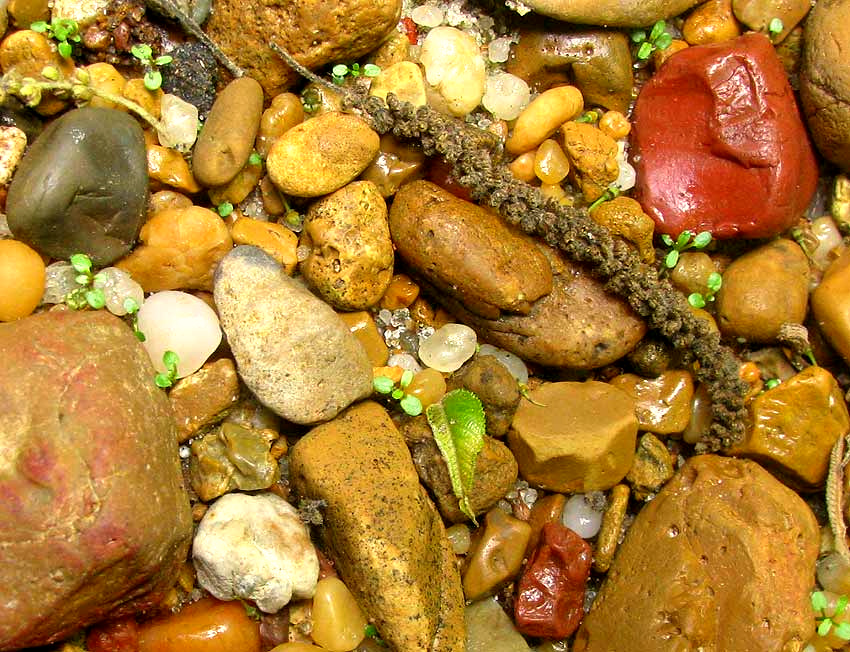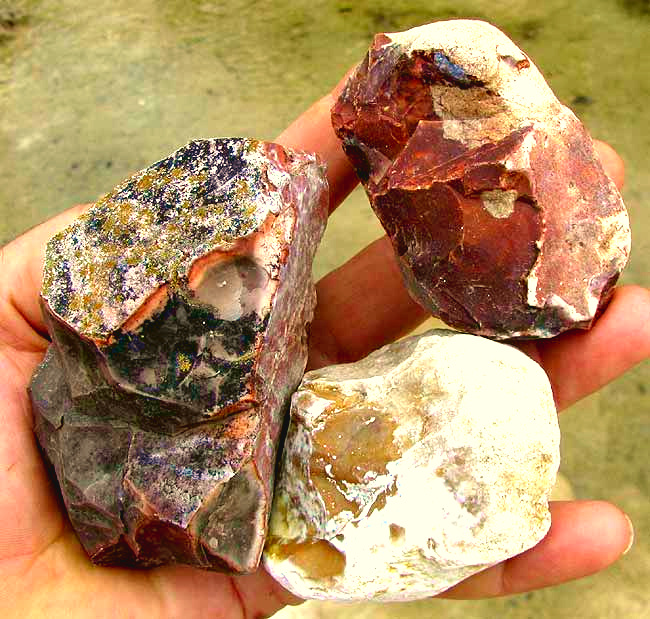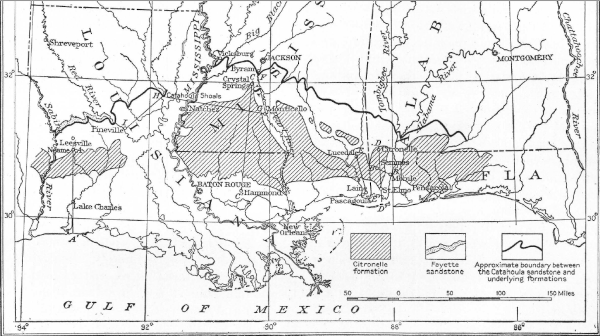
 The floor of a certain usually-dry stream in southwestern Mississippi, USA, is rather sandy with occasional deposits of gravel. That gravel and any naturally occurring body of gravel is fascinating stuff. It's fun to lie on one's belly with the nose about a finger-length from it, exploring every pebble, trying to understand something about each pebble, and what its history might be. A random sample of that exact Mississippi gravel is shown at the right.
The floor of a certain usually-dry stream in southwestern Mississippi, USA, is rather sandy with occasional deposits of gravel. That gravel and any naturally occurring body of gravel is fascinating stuff. It's fun to lie on one's belly with the nose about a finger-length from it, exploring every pebble, trying to understand something about each pebble, and what its history might be. A random sample of that exact Mississippi gravel is shown at the right.
Looking into gravel, the mind has at least two main paths to take.
PATH 1:

Taking the first path with the above image, the first thing to notice is that all the pebbles are rounded. Therefore, they've come a long way -- maybe hundreds of miles -- rolling and tumbling in rushing water, sometimes in pretty streams like that shown at the left, having their corners knocked off, becoming more and more spherical, smooth and smaller.
Something else to notice -- and you notice this only if you pay attention and learn about your local rocks and minerals -- is that they're all silicates. They're all mostly composed of atoms of silicon and oxygen, the two most common elements of which the Earth's crust is composed. Silicon provides about 28% of the Earth's crust by weight, and oxygen some 47%.

However, the pebbles contain different amounts of other elements, too -- sometimes referred to as "impurities" -- so they display various colors and textures, and have different densities. At the right, those chalcedony rocks also are silicates. They're from a different stream, however, and have different histories and different impurities than our pebbles. Still, they're good examples of the kinds of rocks our pebbles were before being broken down to be smooth, rounded, much smaller pebbles.
Most of the pebbles -- the yellow-brown ones -- are chert. Highway engineers might call this chert gravel. The reddish pebble at the picture's upper, right corner is chert containing much more iron oxide than the other pebbles, and it bears the special name of jasper. This is low-grade jasper, though. Finer-textured jasper rocks are considered semiprecious gemstones and can be polished to be made very pretty. The white pebbles are more purely silicon dioxide. The brightest white pebbles showing translucency and very fine texture are fairly pure quartz, or silicon dioxide, but they contain too many impurities to be pure quartz, or crystalline. The pure white ones are sometimes called white quartz. Tiny, transparent sandgrains are crystalline quartz -- pure silicon dioxide, SiO2.
PATH 2:
The second train of thought gravel sets our minds on begins with the question, "Where does this gravel come from?"
Our Mississippi gravel offers a sample of what gravel history can be like. Gravel deposits in your area may be very different, but just as interesting or more so.
Most places in North America and Europe have publications and/or websites describing local geology. Those sources can be discovered by using a search engine with keywords like "geology Mississippi gravel." At this time a search on those keywords leads directly to David Dockery's Rocks and Fossils Found in Mississippi's Gravel Deposits.
"Gravels in Mississippi streams are stones ripped from bedrock from as far away as the Nashville Dome area in Tennessee and the Appalachian Mountains of Alabama," Dockery tells us right off. Further, the age of the stone the gravel is made from ranges from 439 to 323 million years old, far older than any dinosaur. The stone itself is from a time when Tennessee was covered with ocean, and the Appalachians were newly arisen, snow-capped peaks, while our gravel particles still are in the process of being rolled and tumbled, becoming ever more rounded, smoother and smaller.
The oldest ancient rivers carrying our gravel from Tennessee and Alabama into Mississippi did so 93.5-85.8 millions years ago. There was at least one other major gravel-transporting event. The most recent episode occurred only 5.5-1.7 million years ago. That gravel was deposited in a unit known as the "Citronelle Formation."
 Map from The Pliocene Citronelle Formation of the Gulf Coastal Plain, USGS Professional Paper 98, 1916, by George Charlton Matson; image from Wikimedia Commons"
Map from The Pliocene Citronelle Formation of the Gulf Coastal Plain, USGS Professional Paper 98, 1916, by George Charlton Matson; image from Wikimedia Commons"Nowadays in many places the Citronelle Formation -- its location shown at the left embracing our gravel's location -- is being used as a source of gravel for roadbuilding and more, plus it's being eroded away by the usual erosional processes. Its gravels now occupy "... the prolific gravel bars in southern Mississippi streams," Dockery says, plainly referring to our gravel.
Thus, our silicate gravel ripped from Tennessee and Alabama bedrock 439 to 323 million years ago has been transported and retransported, the fragments tumbling, breaking and gradually being rounded and diminished in size, until now they repose calmly and prettily on our stream floor. Calmly, that is, until the next storm transports them a little father, rounding and diminishing even more, during the process surely begetting sandgrains for some future beach we can hardly imagine.